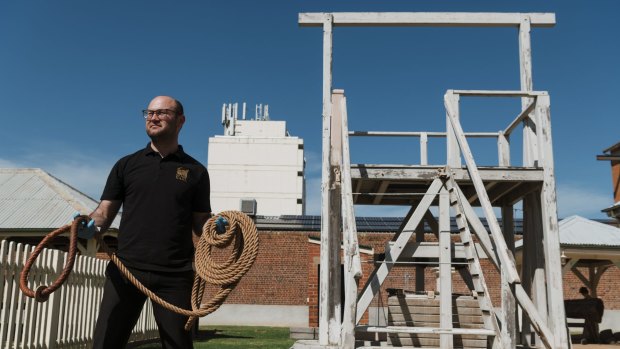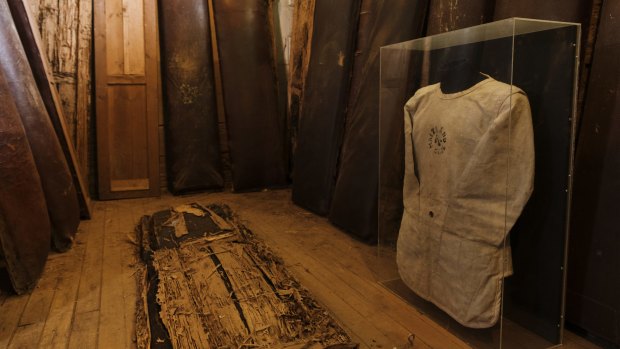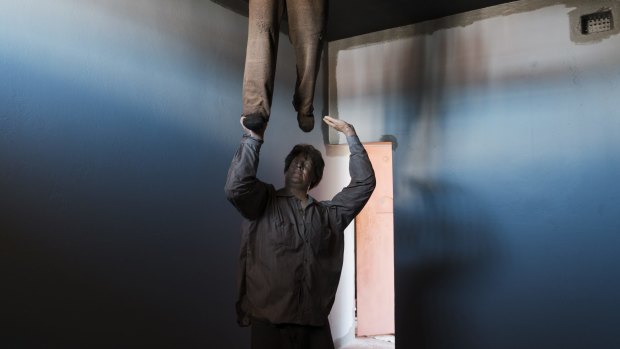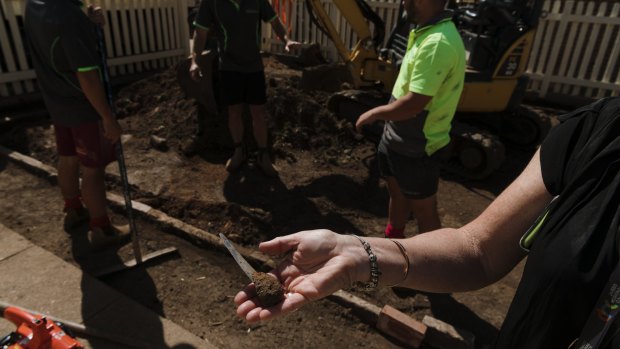This was published 3 years ago
Old Dubbo Gaol, NSW: Hangman's ropes form grisly new museum exhibit
By Anthony Dennis

Christopher Anemaat, the gaol's visitor experience officer, shows off one of the hangman's nooses in front of the gallows replica.Credit: James Brickwood
There is gallows humour, but, in reality, no humour in gallows, especially if you're standing condemned atop one. Yet in Dubbo, news of a state hangman's "kit", consisting of 13 (yes, really) ropes, is enough to bring a smile to a curator's face.
Grim as it is, no noose, in this particular context, is a bad noose as the kit, which includes the hangman's original travelling trunk, pinions for binding a prisoner's legs and a condemned man's mask, is a precious artifact.
They're officially listed as items of national significance by the National Library of Australia and represent the largest collection of surviving hangman's ropes in Australia.

The original padded cell, for psychiatric prisoners, and a straitjacket.Credit: James Brickwood
The ropes, and the other associated items from this most grisly of killing kits, will be part of a newly-curated exhibition at the restored Old Dubbo Gaol museum, located on Macquarie Street, the central west town's main thoroughfare.
Julie Webster, operations coordinator for Old Dubbo Gaol, says that the former institution, which began as a courthouse lockup in 1847, is listed on the National Estate of NSW because of its "uncommon completeness".
"Most of the other NSW country jails have been removed, demolished, or altered so significantly that it is not easy to interpret their origins and functions," she says. "In this respect, Old Dubbo Gaol has a high significance for the state and for the region beyond the Blue Mountains."

A recreation of a a failed escape attempt by prisoners through the jail roof. The complex operated as a jail from 1859 until 1966 and in 1974 was reopened as a tourist attraction.Credit: James Brickwood
The complex operated as a jail from 1859 until 1966 and in 1974 was reopened as a tourist attraction. Today it attracts up to 50,000 visitors each year, though that figure will surely increase as a result of the $1.4 million worth of major improvements funded by NSW Government and Dubbo Regional Council grants
The restored open-air, or external, gallows at the jail are an exact replica of the original version, with elements that included some of the original parts. Those parts will be removed so that they can be included in the new hangman's display set to open to the public in mid-December.
"The replica gives visitors a powerful view of the gallows as they would have stood," says Mrs Webster. "It is the only external replica of a gallows in Australia, thus it gives people a physical sense of its size and its foreboding presence in the jail yard."

An old shiv found by builders while restoring a part of the gaol's yard. Credit: James Brickwood
Even if you weren't sentenced to hang, the writing was, literally, on the wall for many other prisoners. A painstaking process of cataloguing and photographing every piece of graffiti at the jail, has been undertaken prior to the restoration.
In the cell block, a number of prisoner names have been revealed under decades of accumulated layers of paint, as well as symbols such as love hearts and swastikas, drawings of native animals and even landmarks like the Sydney Harbour Bridge.
Eight men were hanged at the jail, with 24 others condemned to death, the last being William Alfred King in 1918. His rape sentence commuted to 10 years penal servitude due to his "mental condition".
Between 1820 and 1839 there were an estimated 458 people executed in NSW but in the period 1900 to 1939 the number declined to two dozen. This was a result of factors such as a reduction in the number of crimes listed as capital offences and changing attitudes to capital punishment.
Old Dubbo Gaol's most notorious executioner was Robert "Nosey Bob" Howard who acquired his darkly ironic name after losing his proboscis from a horse kick while working as a hansom cab driver. The tragically confronting disfigurement led him to seek alternative employment in the less than sought-after role of executioner.
He performed a number of the executions at Dubbo Gaol in the late 19th century, including one that went horrifically wrong and for which he was widely condemned (criticised, that is, not executed).
Traveller editor Anthony Dennis and photographer James Brickwood travelled courtesy of Destination NSW. See visitnsw.com
Sign up for the Traveller Deals newsletter
Get exclusive travel deals delivered straight to your inbox. Sign up now.